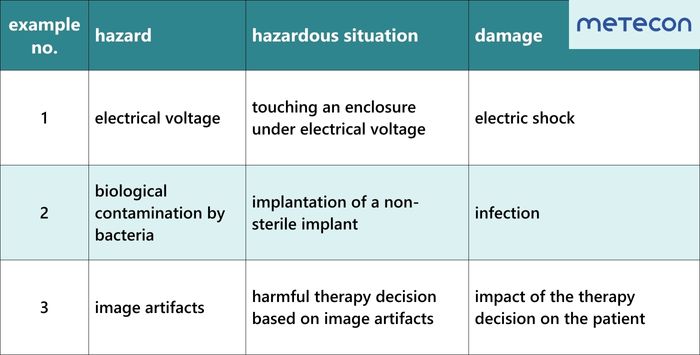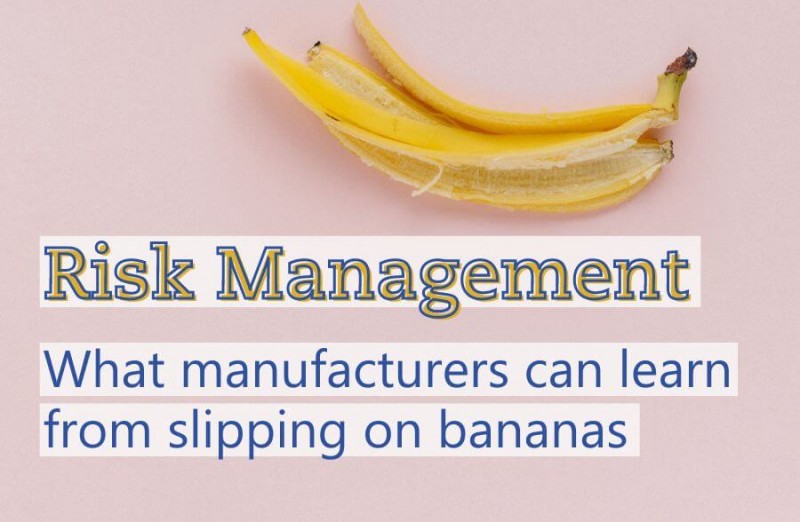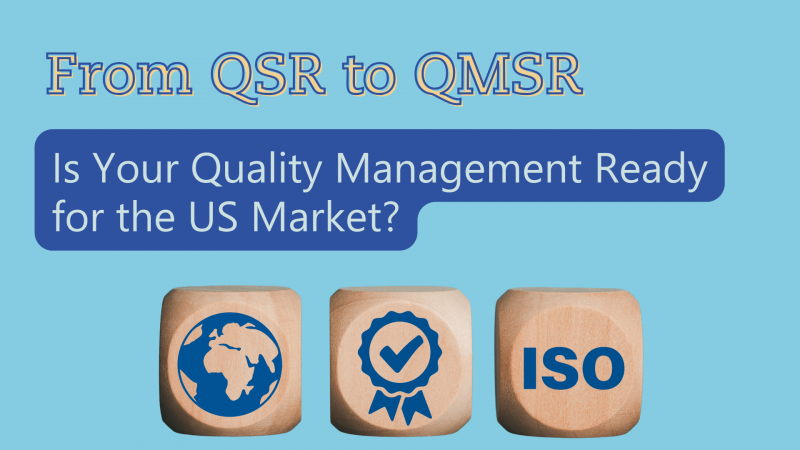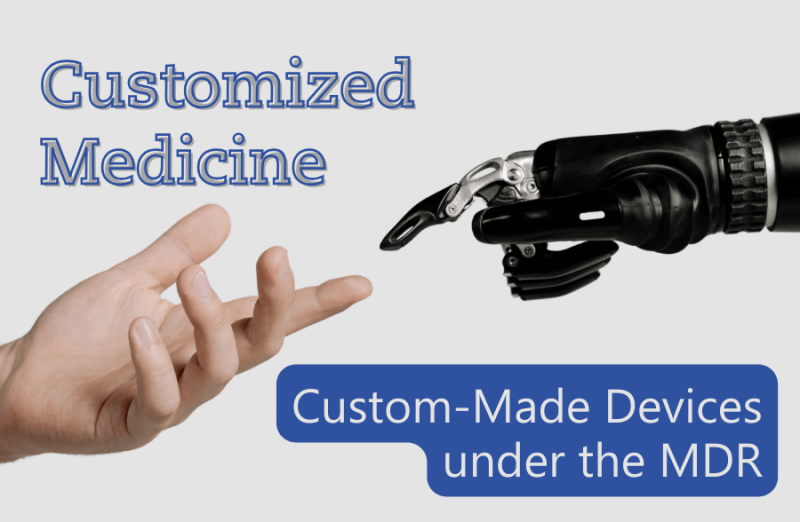The Banana, the Fall - and what manufacturers can learn from it for risk management of the medical devices
21/06/2023
What does risk management of the medical devices have to do with bananas? A lot. Why? Find out in this article on risk analysis according to ISO 14971. It explains, for example, how manufacturers of medical devices can avoid misunderstandings in their technical documentation - especially regarding the assessment of the indirect damage caused by in vitro diagnostics (IVD).Manufacturers of medical devices/in vitro diagnostics (IVD) must ensure that their products perform as they claim and are safe - that is, free of unacceptable risks. These requirements are set by the EU Medical Device Regulation (EU) 2017/745 (MDR) and the EU In Vitro Diagnostic Medical Device Regulation (EU) 2017/746 (IVDR), as well as by ISO 13485 and various international regulations. ISO 14971 "Medical devices - Application of risk management of the medical devices" supports European manufacturers in achieving this goal and setting up a MDR/IVDR-compliant risk management process. However, we have noticed time and again that there are misunderstandings about the terms used in ISO 14971 and that, for example, hazardous situations and the foreseeable sequence of events are not adequately described. Therefore, we would like to bring light into the darkness with this article. In addition, we would also like to highlight the special features of in vitro diagnostic devices (IVD), since these products do not always cause damages directly. You may be wondering what ISO standards and EU directives have to do with a banana mentioned at the beginning? Quite a lot.
Before we get into the banana, let's first recall the terminology used in ISO 14971. According to this, a risk analysis can consist of the following four items:
The "hazard" describes the potential source of damage. Annex C of ISO 14971 (Table C.1) contains a list of examples. For example, hazards such as 1. Electrical voltage, 2. Biological contamination by bacteria, or 3. The presence of image artifacts can be the source of damage for someone to 1. Suffer an electric shock and perhaps get burned, 2. Become infected with bacteria, or 3. Suffer the effects of incorrect therapy or have to repeat a complex imaging procedure (tab. 1). This already explains the concept of "damage", which is defined as "injury or damage to human health" or "damage to property or the environment". The remaining items are the "hazardous situation" and the "reasonably foreseeable sequence of events":
table 1: Example scenarios for hazard, hazardous situation and damage according to ISO 14971
example no. hazard hazardous situation damage
So far, so clear? Then let's bring in the banana, which has already made many a head spin.Imagine yourself walking through any downtown on a Saturday after a rainstorm. You look at the beautiful facades and ignore where your feet are taking you. Therefore, you don't notice that you step on a banana peel that someone carelessly threw on the ground. You slip and fall. Trying to intercept the fall, you fall on your hands, unfortunately breaking your right wrist. Now the crucial question: in this scenario, what are the actual hazard, the foreseeable sequence of events, the hazardous situation, and the damage? In this case, a common thinking error is obvious. For example, the banana peel is immediately identified as the culprit and thus defined as the "hazard." The "foreseeable sequence of events" consists of the careless throwing away of the banana peel and the fact that you stepped on it. The "hazardous situation" results from the slipping, and the "damage" is the fracture of the wrist. However, the factual situation is not quite so simple otherwise, there would not be this "darn" problem with the banana.The problem already begins with the identification of the hazard. Of course, the banana in this case is the culprit to play the key role in the sequence of events. However, it is not the source of damage that causes someone to fall and break the wrist. The real culprit was discovered by a physicist in 1665 during an incident involving another type of fruit: the earth's gravity is the real hazard, as it inexorably pulls us toward the ground. It is the real cause that we can fall and break our wrists. Based on this, we can now also identify the correct hazard situation. It is not slipping on the banana peel but falling onto our hands that can cause us to break our wrists. At this point, an important note: of course, falling on your hands does not necessarily mean you will also break your wrists. Less tragic damage can also occur, or even nothing at all can happen. Therefore, the question arises as to what damage should be considered. Do you always have to assume the worst case? No. The damage consideration must make sense and be within the scope of the application. However, do not be too thrifty with your damage assessment. If your PMS system reveals new damage that you had not yet considered in your previous risk analysis, you must update it and include the new one.Back to the banana problem: Everything that happened before the fall onto the hands is obviously part of the foreseeable sequence of events. Even the rain could be important if it is necessary for a pleasing slide effect. When describing the predictable sequence of events, it is advisable not to be too brief. This is exactly the starting point where you, as the manufacturer, can intervene with your risk control measures to minimize the risk. Also, keep in mind that a foreseeable sequence of events can lead to multiple hazardous situations. The banana could additionally mold and release toxic fungal spores. Finally, our thought experiment ends with the damage: the fracture of the wrist.
Let's return from the banana to in vitro diagnostic (IVD) devices. They present additional hazards compared to medical devices. Annex H of ISO/TR 24971 provides helpful examples of the potential hazards that can occur, and thus supplements Table C.1 of ISO 14971. Among other things, incorrect therapy results are IVD-typical potential sources of damage. For example, a physician very often makes a therapy decision for a patient based on a laboratory result. Two damage scenarios are conceivable here:
In both cases, the physician often receives the information from the de facto user of the in vitro diagnostic (IVD) device, who works in a medical laboratory, for example. This means that any guidance you have included in the supporting documentation is unlikely to get to the physician but will only reach the users in the laboratory. Therefore, a risk control measure does not necessarily mitigate a risk if it merely consists of informing the physician in the accompanying documentation that he or she must not use the test result alone for diagnosis. Only verification by a usability study can confirm that this notice has a risk-reducing effect. Manufacturers of in vitro diagnostic (IVD) devices must therefore be aware of the impact that incorrect treatment decisions based on their test results could have on patients. Since assessing the potential damages is challenging, subject matter experts should be consulted. At this point, the close interface with performance evaluation becomes apparent, where the "state of the art" and the benefits of the product are discussed. Thus, it provides the basis for the benefit-risk assessment in risk management.
Your risk management file is a core document in your technical documentation. It is updated throughout the entire product life cycle, and it serves as the basis for guiding decisions. It is even more important that the hazards, the foreseeable sequence of events, and the hazardous situations are precisely defined in the risk analysis, as the risk control measures are based on this. The risk management of in vitro diagnostic (IVD) devices is even more complex, as patients can also be indirectly harmed by an incorrect therapy. Thus, manufacturers need to carefully consider the potential consequences for patients of treatment failure based on an incorrect result. Estimating indirect damages is not always easy. Therefore, it is important to involve experts to adequately assess the potential damage.Do you have an appetite for bananas now? In this case, unfortunately, we can't help you. However, we recommend that you dispose of the banana peel in accordance with local regulatory requirements to prevent worse. Instead of bananas, we can offer you our support when it comes to creating a compliant risk management file. Our team of experts will be happy to discuss any other questions you may have regarding risk management and technical documentation for medical devices and in vitro diagnostics (IVD). We look forward to hearing from you for a free, no-obligation initial consultation.Best regards and bon appétit,
Björn-Carsten Schüre
1 Definition of risk management terms
Before we get into the banana, let's first recall the terminology used in ISO 14971. According to this, a risk analysis can consist of the following four items:
- hazard,
- reasonably foreseeable sequence of events,
- hazardous situation and
- damage.
The "hazard" describes the potential source of damage. Annex C of ISO 14971 (Table C.1) contains a list of examples. For example, hazards such as 1. Electrical voltage, 2. Biological contamination by bacteria, or 3. The presence of image artifacts can be the source of damage for someone to 1. Suffer an electric shock and perhaps get burned, 2. Become infected with bacteria, or 3. Suffer the effects of incorrect therapy or have to repeat a complex imaging procedure (tab. 1). This already explains the concept of "damage", which is defined as "injury or damage to human health" or "damage to property or the environment". The remaining items are the "hazardous situation" and the "reasonably foreseeable sequence of events":
- The latter describes a combination of events related to a hazard that result in one or more hazardous situations.
- A "hazardous situation" is the circumstance under which people, goods, or the environment are exposed to one or more hazards. It is therefore the last event that must occur for damage to result from the hazard: 1. Someone touches an enclosure which is under electrical voltage, 2. Someone is implanted with a non-sterile implant, or 3. Someone is given the wrong treatment due to a misdiagnosis (tab. 1).
table 1: Example scenarios for hazard, hazardous situation and damage according to ISO 14971
example no. hazard hazardous situation damage

2 The appearance of the banana
So far, so clear? Then let's bring in the banana, which has already made many a head spin.Imagine yourself walking through any downtown on a Saturday after a rainstorm. You look at the beautiful facades and ignore where your feet are taking you. Therefore, you don't notice that you step on a banana peel that someone carelessly threw on the ground. You slip and fall. Trying to intercept the fall, you fall on your hands, unfortunately breaking your right wrist. Now the crucial question: in this scenario, what are the actual hazard, the foreseeable sequence of events, the hazardous situation, and the damage? In this case, a common thinking error is obvious. For example, the banana peel is immediately identified as the culprit and thus defined as the "hazard." The "foreseeable sequence of events" consists of the careless throwing away of the banana peel and the fact that you stepped on it. The "hazardous situation" results from the slipping, and the "damage" is the fracture of the wrist. However, the factual situation is not quite so simple otherwise, there would not be this "darn" problem with the banana.The problem already begins with the identification of the hazard. Of course, the banana in this case is the culprit to play the key role in the sequence of events. However, it is not the source of damage that causes someone to fall and break the wrist. The real culprit was discovered by a physicist in 1665 during an incident involving another type of fruit: the earth's gravity is the real hazard, as it inexorably pulls us toward the ground. It is the real cause that we can fall and break our wrists. Based on this, we can now also identify the correct hazard situation. It is not slipping on the banana peel but falling onto our hands that can cause us to break our wrists. At this point, an important note: of course, falling on your hands does not necessarily mean you will also break your wrists. Less tragic damage can also occur, or even nothing at all can happen. Therefore, the question arises as to what damage should be considered. Do you always have to assume the worst case? No. The damage consideration must make sense and be within the scope of the application. However, do not be too thrifty with your damage assessment. If your PMS system reveals new damage that you had not yet considered in your previous risk analysis, you must update it and include the new one.Back to the banana problem: Everything that happened before the fall onto the hands is obviously part of the foreseeable sequence of events. Even the rain could be important if it is necessary for a pleasing slide effect. When describing the predictable sequence of events, it is advisable not to be too brief. This is exactly the starting point where you, as the manufacturer, can intervene with your risk control measures to minimize the risk. Also, keep in mind that a foreseeable sequence of events can lead to multiple hazardous situations. The banana could additionally mold and release toxic fungal spores. Finally, our thought experiment ends with the damage: the fracture of the wrist.
3 In vitro diagnostics (IVD) - the indirect damage
Let's return from the banana to in vitro diagnostic (IVD) devices. They present additional hazards compared to medical devices. Annex H of ISO/TR 24971 provides helpful examples of the potential hazards that can occur, and thus supplements Table C.1 of ISO 14971. Among other things, incorrect therapy results are IVD-typical potential sources of damage. For example, a physician very often makes a therapy decision for a patient based on a laboratory result. Two damage scenarios are conceivable here:
- The test was false-positive: the patient may undergo painful and unnecessary therapy as a result.
- The test was false-negative: Under certain circumstances, the patient's condition may worsen because the patient is not treated as a result.
In both cases, the physician often receives the information from the de facto user of the in vitro diagnostic (IVD) device, who works in a medical laboratory, for example. This means that any guidance you have included in the supporting documentation is unlikely to get to the physician but will only reach the users in the laboratory. Therefore, a risk control measure does not necessarily mitigate a risk if it merely consists of informing the physician in the accompanying documentation that he or she must not use the test result alone for diagnosis. Only verification by a usability study can confirm that this notice has a risk-reducing effect. Manufacturers of in vitro diagnostic (IVD) devices must therefore be aware of the impact that incorrect treatment decisions based on their test results could have on patients. Since assessing the potential damages is challenging, subject matter experts should be consulted. At this point, the close interface with performance evaluation becomes apparent, where the "state of the art" and the benefits of the product are discussed. Thus, it provides the basis for the benefit-risk assessment in risk management.
4 Conclusion
Your risk management file is a core document in your technical documentation. It is updated throughout the entire product life cycle, and it serves as the basis for guiding decisions. It is even more important that the hazards, the foreseeable sequence of events, and the hazardous situations are precisely defined in the risk analysis, as the risk control measures are based on this. The risk management of in vitro diagnostic (IVD) devices is even more complex, as patients can also be indirectly harmed by an incorrect therapy. Thus, manufacturers need to carefully consider the potential consequences for patients of treatment failure based on an incorrect result. Estimating indirect damages is not always easy. Therefore, it is important to involve experts to adequately assess the potential damage.Do you have an appetite for bananas now? In this case, unfortunately, we can't help you. However, we recommend that you dispose of the banana peel in accordance with local regulatory requirements to prevent worse. Instead of bananas, we can offer you our support when it comes to creating a compliant risk management file. Our team of experts will be happy to discuss any other questions you may have regarding risk management and technical documentation for medical devices and in vitro diagnostics (IVD). We look forward to hearing from you for a free, no-obligation initial consultation.Best regards and bon appétit,
Björn-Carsten Schüre
 |
| Björn-Carsten Schüre |
| PMS Expert Regulatory Affairs & Technical Documentation |
| bjoern-carsten.schuere@metecon.de |
Our blog posts are researched and created with the utmost care, but are only snapshots of the regulations, which are constantly changing. We do not guarantee that older content is still current or meaningful. If you are not sure whether the article you have read on this page still corresponds to the current state of regulation, please contact us: we will quickly place your topic in the current context.



